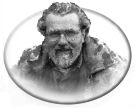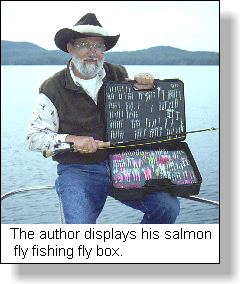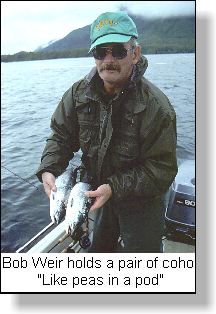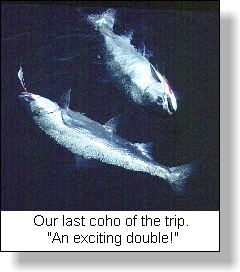
Saltwater
Fly Fishing Series
"Vancouver
Island's West Coast Salmon Fly Fishing"
with
Barry M. Thornton
 There
is a wild enchantment about the west coast that embraces the
visiting angler. When a raging southeast storm builds meter
high waves that crash on rocky islands; when ferocious white
water foam splashes house high; when salmon strike during drenching
downpours; then, there is a true raw attraction to this special
side of our island. This was the fascination, our engrossment
in this rare location during most of our five day trip to Tofino late in June. No, fishers are not addled, only
those who have experienced raw nature can truly understand the
adrenaline rush that such conditions provoke.
There
is a wild enchantment about the west coast that embraces the
visiting angler. When a raging southeast storm builds meter
high waves that crash on rocky islands; when ferocious white
water foam splashes house high; when salmon strike during drenching
downpours; then, there is a true raw attraction to this special
side of our island. This was the fascination, our engrossment
in this rare location during most of our five day trip to Tofino late in June. No, fishers are not addled, only
those who have experienced raw nature can truly understand the
adrenaline rush that such conditions provoke.
I
was staying at Weigh
West Marine Resort along with friends from the North Okanagan. Dick Close, the owner, has pioneered a salmon
fly fishing fleet from his resort which has opened a totally
new sports fishing opportunity in Clayoquot Sound and the Pacific Rim. Our long planned
trip was aimed at this salmon fly fishing and, while the weather
provided an additional exciting challenge, it did not stop us
from venturing into those protected waters of Clayoquot Sound
north of Tofino. Daily we boated over the shallow intertidal
bays and inlets in this vast region visiting various islands
and shoals looking for feeding coho. They were there, not in
great numbers at this early migration date, but, sufficient
to appease our needs. What was special about these salmon was
the locations where we found them and the equipment we were
using.
 We were fly fishing
for these saltwater sports salmon, using traditional casting
methods brought to the coast from our Interior upbringing. We
were pleased yet frustrated when we found that they would actively
attack a 'bucktailed' surface fly but, only on occasion, take
a cast fly. However, bucktailing allowed us to find those particular
patterns which these coho preferred and gave us the confidence
to persist when nearby jumpers tantalized.
We were fly fishing
for these saltwater sports salmon, using traditional casting
methods brought to the coast from our Interior upbringing. We
were pleased yet frustrated when we found that they would actively
attack a 'bucktailed' surface fly but, only on occasion, take
a cast fly. However, bucktailing allowed us to find those particular
patterns which these coho preferred and gave us the confidence
to persist when nearby jumpers tantalized.
We
found two distinct schools of coho in the waters in front of
Catface Mountain. The first were smaller fish about, 42 cm in
length, and were like peas in a pod when placed side by side.
This particular school we found in the shallow bays ( 3 to 6
meters) and rocky outcrops on the south face of the Catface
Range. It was exciting fishing for often in the clear water
we watched 'followers', curious coho, noses almost stuffed in
the tail of our flies, come right to the boat.
The
second school of coho hunted the shallows ( 6 to 10 meter) of
Coomes Bank, immediately south of the Catface Range. These were
larger coho and they were obviously targeting the young herring
and needlefish that frequent this very fishy sports fishing
location. We tried various cast flies in these waters but found
it difficult to retain position with our anchor on the sandy
flat. However, we did manage an exciting double as the last
fish of our trip using bright attractor flies.
 Coomes Bank is the ideal
bucktailing location and seemed to have coho activity on both
the flooding and ebbing tides. We would simply troll our flies
about 15 meters behind the boat using our fast sink fly lines.
We varied the speed and direction in an irregular manner and
this seemed to excite the salmon to strike. It is the 'all day-every
summer day' coho water. It lies about twenty minutes north of
Tofino in Calmus Passage. This is usually protected water which
has large Vargas Island to protect it from southeastern storms
and, an outer coast network of smaller islands to break up the
heavy open Pacific swells.
Coomes Bank is the ideal
bucktailing location and seemed to have coho activity on both
the flooding and ebbing tides. We would simply troll our flies
about 15 meters behind the boat using our fast sink fly lines.
We varied the speed and direction in an irregular manner and
this seemed to excite the salmon to strike. It is the 'all day-every
summer day' coho water. It lies about twenty minutes north of
Tofino in Calmus Passage. This is usually protected water which
has large Vargas Island to protect it from southeastern storms
and, an outer coast network of smaller islands to break up the
heavy open Pacific swells.
On
this trip we were unable to reach the open waters and many islets
of the Pacific rim but we explored many of the protected waters
around Meares Island. In Cypress Bay we motored into the estuary
of a smaller river. Anchoring in the shallows we cast for searun
cutthroat trout and boated and released what can best be called
'footballs', those chunky, deep bellied, golden hued trout.
In
the Tsapee Narrows between Vancouver Island and Meares Island,
another area usually productive for coho in the summer, we found
schools of black bass (rockfish) that could not resist our flies.
It was often a case of a fish on every cast until we stopped
to rest and revel in the scenery.
The
west coast offers a rich open ocean salmon fly fishery extending
from May through October. On this trip we were fishing during
late June, and it was still early for the main schools of coho
to frequent this area as they migrate along the outer west coast.
In previous years I have experienced the swells of the open
Pacific when we were able to anchor near many of the smaller
islands on the outer Pacific rim. Here we fished in September
for those hook-nosed northern coho that were feeding on the
prolific needlefish schools in the area. It was exciting to
have salmon chase the baitfish to the surface while we remained
anchored in enchanting locations near kelp beds. The skills
of hunting, anchoring, structure fishing, and retrieving appear
to be the same anywhere on the open ocean and during all seasons.
Fly fishing for salmon is now a flourishing fly angling sport.
Add the elements of the open Pacific ocean in a true wilderness
setting and you have a fly fishery second to none.
 To fish these waters
be certain you have marine chart, "CLAYOQUOT SOUND, Tofino
Inlet to/a Miller Channel"; chart # 3673. These are shallow
waters and require care when you are travelling. This was my
boat's first trip and I would often follow the wake of whale
watching boats, aluminum water taxis, and other sports boats
while making reference to my chart. While we were usually alone
where we fished there was almost always another vessel in view.
To fish these waters
be certain you have marine chart, "CLAYOQUOT SOUND, Tofino
Inlet to/a Miller Channel"; chart # 3673. These are shallow
waters and require care when you are travelling. This was my
boat's first trip and I would often follow the wake of whale
watching boats, aluminum water taxis, and other sports boats
while making reference to my chart. While we were usually alone
where we fished there was almost always another vessel in view.
For
further information about salmon fly fishing contact:
Weigh
West Resort, Tofino, BC
©
Copyright Barry M. Thornton




 There
is a wild enchantment about the west coast that embraces the
visiting angler. When a raging southeast storm builds meter
high waves that crash on rocky islands; when ferocious white
water foam splashes house high; when salmon strike during drenching
downpours; then, there is a true raw attraction to this special
side of our island. This was the fascination, our engrossment
in this rare location during most of our five day trip to
There
is a wild enchantment about the west coast that embraces the
visiting angler. When a raging southeast storm builds meter
high waves that crash on rocky islands; when ferocious white
water foam splashes house high; when salmon strike during drenching
downpours; then, there is a true raw attraction to this special
side of our island. This was the fascination, our engrossment
in this rare location during most of our five day trip to  We were fly fishing
for these saltwater sports salmon, using traditional casting
methods brought to the coast from our Interior upbringing. We
were pleased yet frustrated when we found that they would actively
attack a 'bucktailed' surface fly but, only on occasion, take
a cast fly. However, bucktailing allowed us to find those particular
patterns which these coho preferred and gave us the confidence
to persist when nearby jumpers tantalized.
We were fly fishing
for these saltwater sports salmon, using traditional casting
methods brought to the coast from our Interior upbringing. We
were pleased yet frustrated when we found that they would actively
attack a 'bucktailed' surface fly but, only on occasion, take
a cast fly. However, bucktailing allowed us to find those particular
patterns which these coho preferred and gave us the confidence
to persist when nearby jumpers tantalized. Coomes Bank is the ideal
bucktailing location and seemed to have coho activity on both
the flooding and ebbing tides. We would simply troll our flies
about 15 meters behind the boat using our fast sink fly lines.
We varied the speed and direction in an irregular manner and
this seemed to excite the salmon to strike. It is the 'all day-every
summer day' coho water. It lies about twenty minutes north of
Tofino in Calmus Passage. This is usually protected water which
has large Vargas Island to protect it from southeastern storms
and, an outer coast network of smaller islands to break up the
heavy open Pacific swells.
Coomes Bank is the ideal
bucktailing location and seemed to have coho activity on both
the flooding and ebbing tides. We would simply troll our flies
about 15 meters behind the boat using our fast sink fly lines.
We varied the speed and direction in an irregular manner and
this seemed to excite the salmon to strike. It is the 'all day-every
summer day' coho water. It lies about twenty minutes north of
Tofino in Calmus Passage. This is usually protected water which
has large Vargas Island to protect it from southeastern storms
and, an outer coast network of smaller islands to break up the
heavy open Pacific swells. To fish these waters
be certain you have marine chart, "CLAYOQUOT SOUND, Tofino
Inlet to/a Miller Channel"; chart # 3673. These are shallow
waters and require care when you are travelling. This was my
boat's first trip and I would often follow the wake of whale
watching boats, aluminum water taxis, and other sports boats
while making reference to my chart. While we were usually alone
where we fished there was almost always another vessel in view.
To fish these waters
be certain you have marine chart, "CLAYOQUOT SOUND, Tofino
Inlet to/a Miller Channel"; chart # 3673. These are shallow
waters and require care when you are travelling. This was my
boat's first trip and I would often follow the wake of whale
watching boats, aluminum water taxis, and other sports boats
while making reference to my chart. While we were usually alone
where we fished there was almost always another vessel in view.